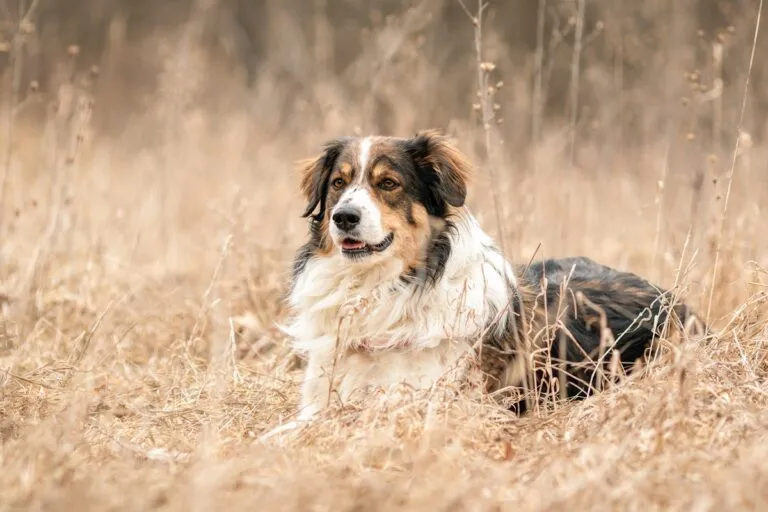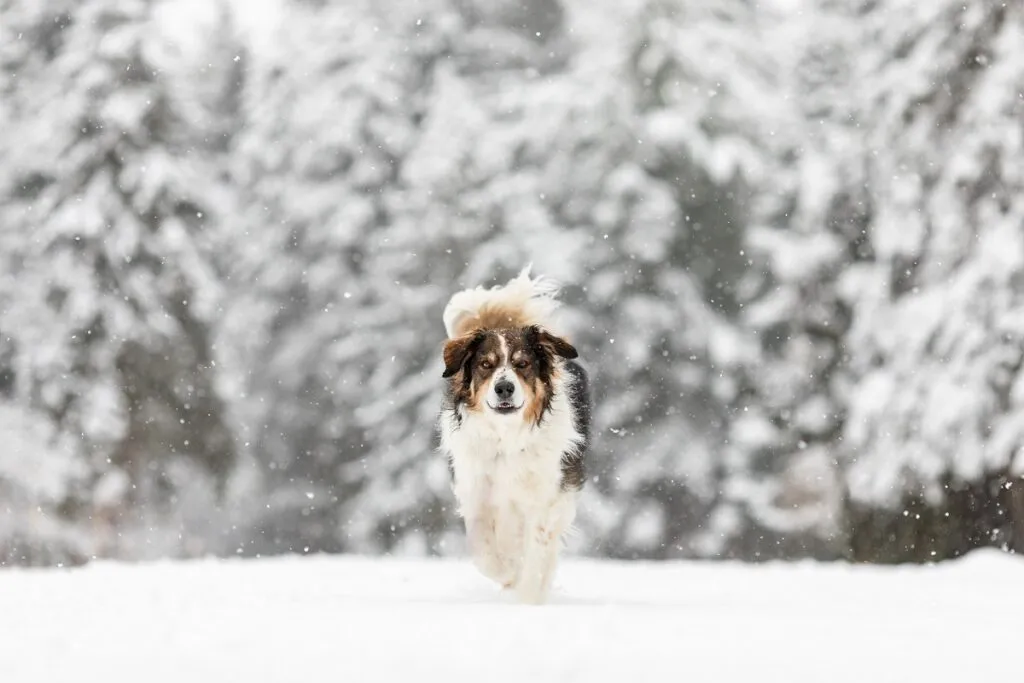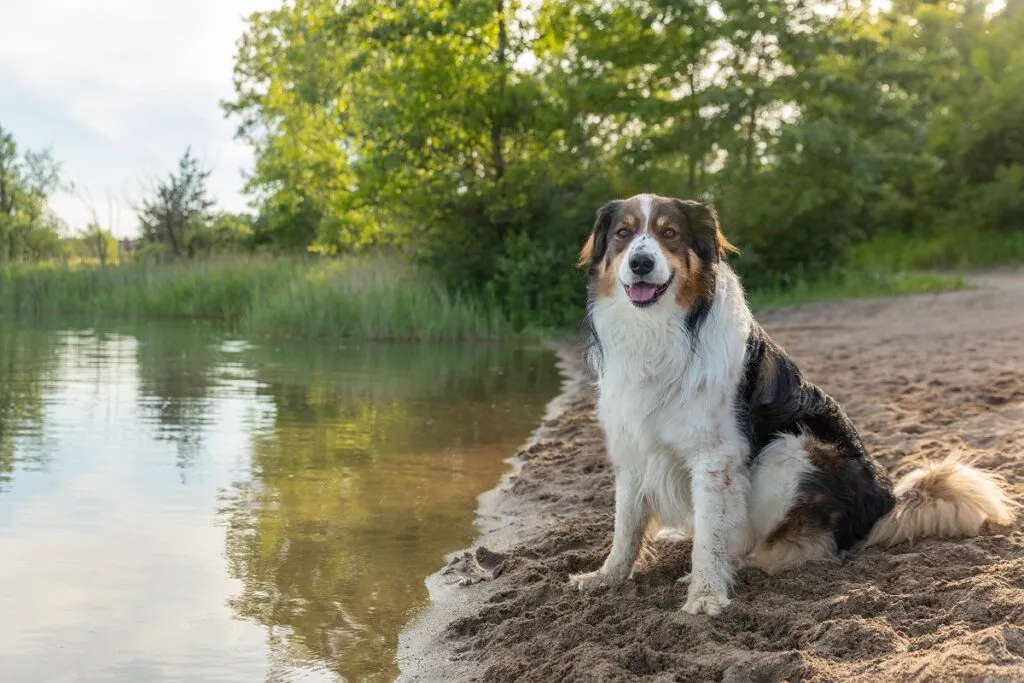Medium Size Poodle
Discover the unique qualities and care requirements of the clever, versatile working dog known as the English Shepherd.

© Jennifer / stock.adobe.com
The English Shepherd is a versatile and sturdy dog breed that originally hails from England.
To many dog lovers, the English Shepherd, which is rare in Europe, might initially resemble a Collie crossbreed. However, its athletic build is characteristic of agile herding dogs.
A medium-sized breed, the English Shepherd weighs between 18 and 27kg. Females stand 46-56cm at the withers, while males range from 48 to 58cm.
Its weather-resistant coat is medium-length, with shorter hair on the head and legs. Colour variations include black and tan, tri-colour, sable, and black and white.
Although most English Shepherds have long tails, according to breed standards, bobtails are also permitted. The ears fold forward, framing the medium-length head with its brown, slightly slanted eyes.
The English Shepherd is a working dog, and according to the breed description in the United Kennel Club (UKC) standard, its character, including exceptional herding traits, is valued more than its looks. Many fans of the breed truly appreciate this aspect.
The English Shepherd is resilient and enduring. It inherits a wealth of talents from its ancestors and thus displays great versatility. Its forebears served as herders, rat-catchers, guard dogs, and loyal family companions.
The breed is known for its equilibrium: the English Shepherd tends to relax when there’s no work to be done. However, this requires appropriate mental and physical stimulation. Even while resting, the English Shepherd remains vigilant, not keen on strangers in its territory, and will defend it if necessary. Some may also have a tendency to bark.
 © Jennifer / stock.adobe.com
© Jennifer / stock.adobe.com
The English Shepherd needs a caring yet firm handler to prevent it from taking control. Even as a balanced working breed, this athletic, intelligent dog needs tasks to perform!
Working with their human partners is paramount for this breed. Along with mental and physical exercise, it’s essential to learn how to unwind and relax from an early age.
Puppies benefit from a structured daily routine that includes opportunities for exertion, mental challenges, and ample relaxation time. This helps curtail any hunting instincts. Attending a dog school experienced with herding breeds is recommended.
The coat of the English Shepherd is weather-resistant and largely self-cleaning. Brushing your dog every few days is usually sufficient. However, if your English Shepherd has a softer and less harsh coat, grooming can be more demanding.
It’s advisable to brush more frequently during the shedding period. A de-shedding tool helps remove loose undercoat. Your dog only needs a bath with dog shampoo if the dirt in its coat does not brush out when dry.
The English Shepherd is not typically suited for novice owners. It brings a high energy level and a strong motivation for independent work, which can be challenging for beginners to manage effectively.
Potential owners should aim to meet many English Shepherds and converse with current owners to understand better what life with this breed might be like.
A well-exercised English Shepherd can integrate seamlessly into family life. If the family includes small children, care should be taken to ensure the dog does not start herding them.
Family activities should mainly occur outdoors, and a private garden is ideal. However, due to its territorial nature, the English Shepherd may not be the quintessential family pet.
The English Shepherd is multifaceted. Suitable for herding, it also excels in dog sports such as Treibball, Agility, and Dog Dance. Trick training can provide mental stimulation and enjoyment. If your dog loves to sniff, Mantrailing or other scent work could be an exciting challenge.
Given its versatility, the English Shepherd could also make an excellent therapy dog. Choose games wisely during the puppy stage, ensuring that activities like ball play include impulse control to prevent the dog from becoming fixated.
The English Shepherd is generally a sturdy breed. Due to the rarity of the breed in Europe, it’s essential to look for a low inbreeding coefficient. Responsible breeders in the USA also place great importance on this to avoid hereditary diseases.
This breed may be prone to hip dysplasia and patellar luxation. Eye problems, such as Collie Eye Anomaly, which can lead to blindness, can also occur.
Before choosing an English Shepherd, discuss health precautions with the breeder. Parent dogs should have clearances for healthy hips and knees. Screening and, to a limited extent, genetic testing can help identify carriers of Collie Eye Anomaly for breeding exclusion.
A healthy English Shepherd can live to be around 12 years old or longer.
A healthy English Shepherd does not require specialised dog food. Opt for high-quality, easily digestible dog food with a high meat content that suits the needs, health status, and activity levels of your pet.
The ancestors of the English Shepherd were indispensable helpers on farms in what is now the USA. They arrived with immigrants from Ireland, Scotland, and England, spreading westward with the settlers.
Defending settlers’ possessions was crucial, thus the English Shepherd’s multifaceted abilities from rat-catching, herding livestock, to guarding and protecting were utilised. In 1927, the United Kennel Club recognised the English Shepherd as a distinct breed.
 © Jennifer / stock.adobe.com
© Jennifer / stock.adobe.com
English Shepherds are scarce in Europe and not recognised by the FCI. However, those determined to find one should scrutinise breeders closely: ensure the health of the parent animals. Visit the breeder’s home and personally assess the puppies’ environment.
While possible, acquiring a puppy from the USA involves considerable effort and isn’t an option until after it has been vaccinated against rabies.
An English Shepherd from a breeder starts at around £1,500, but prices can be higher due to its rarity in Europe. However, this should not justify fantasy prices of £4,000 or more.
Collies and Border Collies, both involved in the breed’s creation, share similar traits with the English Shepherd and are more commonly found in Europe.
Therefore, finding a reputable breeder is easier, and these breeds are often available for adoption through animal welfare organisations. A look at Retrievers could also be worthwhile; the Nova Scotia Duck Tolling Retriever shares some features with working Collies and is similarly sized.
Enthusiasts adore the English Shepherd as a versatile and natural companion. With the breed’s lack of recognition by the FCI, acquiring one from a reputable breeder in Europe is challenging. Prospects are better in the USA, where the breed’s balanced nature is winning over more and more dog lovers.
| Key features: The English Shepherd, not recognised by the FCI, hails from the USA. This medium-sized canine is athletic, multifaceted and a fine companion for active individuals. |
| Character: sturdy, agile, active, intelligent, territorial |
| Height at the withers: Male: 48-58cm | Female: 46-56cm |
| Weight: Male: 20.5-27kg | Female: 18-22.5kg |
| Coat: medium-length coat with undercoat and top coat, colours: black and tan, tri-colour, sable, and black and white |
| Coat care: brush once weekly, more often during shedding |
| Exercise: high (working dog requiring daily tasks) |
| Beginner-friendly: no |
| Barking: prone to territorial barking |
| Life expectancy: approximately 12 years |
| Common illnesses: hip dysplasia, patellar luxation, eye conditions such as Collie Eye Anomaly, limited gene pool |
| Price: £600-1200 |
Here are some purchase proposals curated by the zooplus editorial team
The products featured have been carefully selected by our editorial staff and are available at the zooplus online pet shop. The selection does not constitute advertising for the mentioned brands.
Fans of the Bearded Collie agree that those who aren't familiar with this dog breed simply have to get acquainted with it. And those who have experienced how a Bearded Collie bolts across meadows with its flowing fur, how it rolls around full of energy and joy and how it attentively and observantly takes into account its owners wishes become simply addicted to this original dog breed and its unique charm.
The Goldendoodle isn't a breed, but a pairing between Golden Retrievers and Medium or Standard Poodles. Marketed as a low-maintenance dog for allergy sufferers, this hybrid is enjoying increasing popularity amongst dog lovers, similar to the Labradoodle.